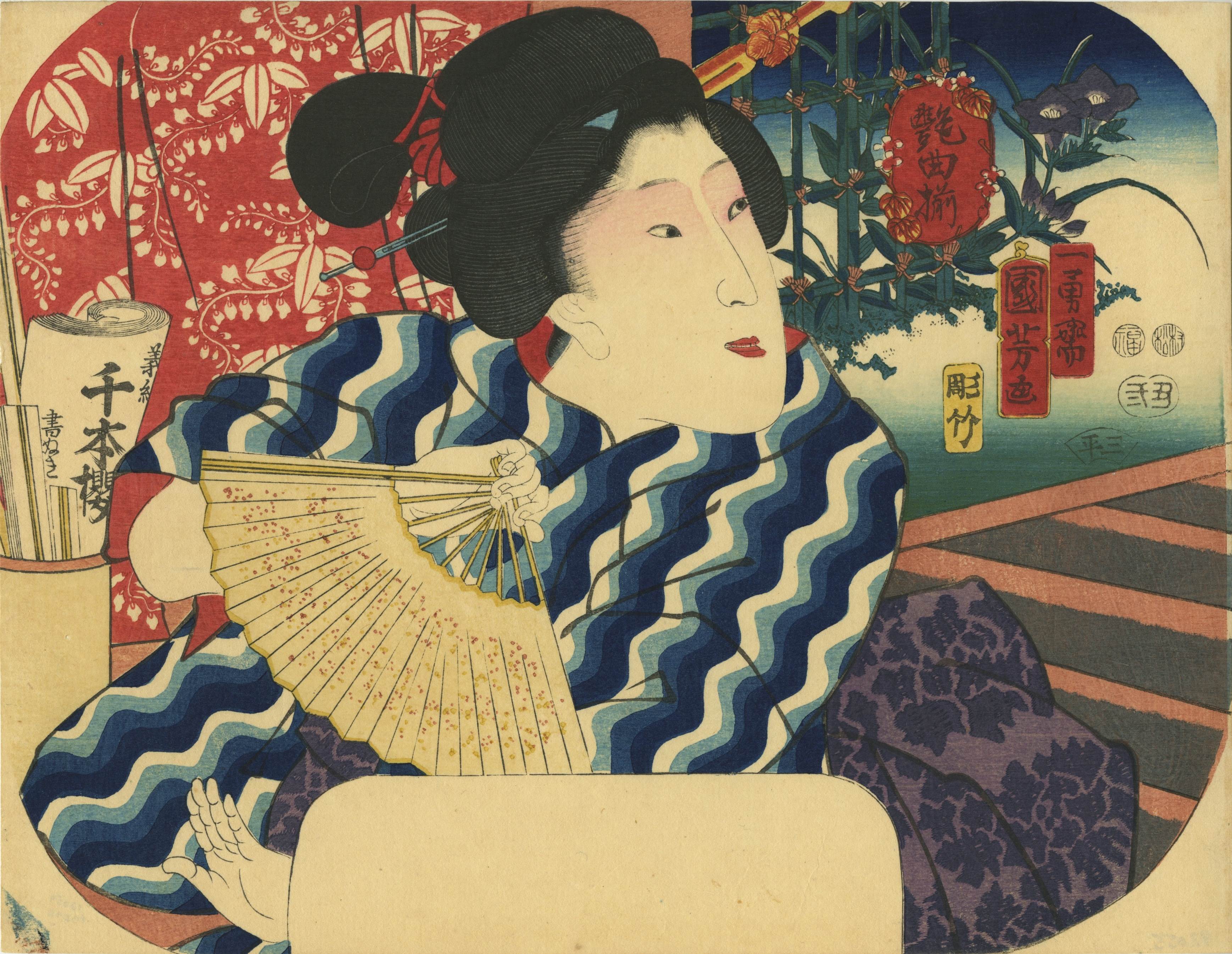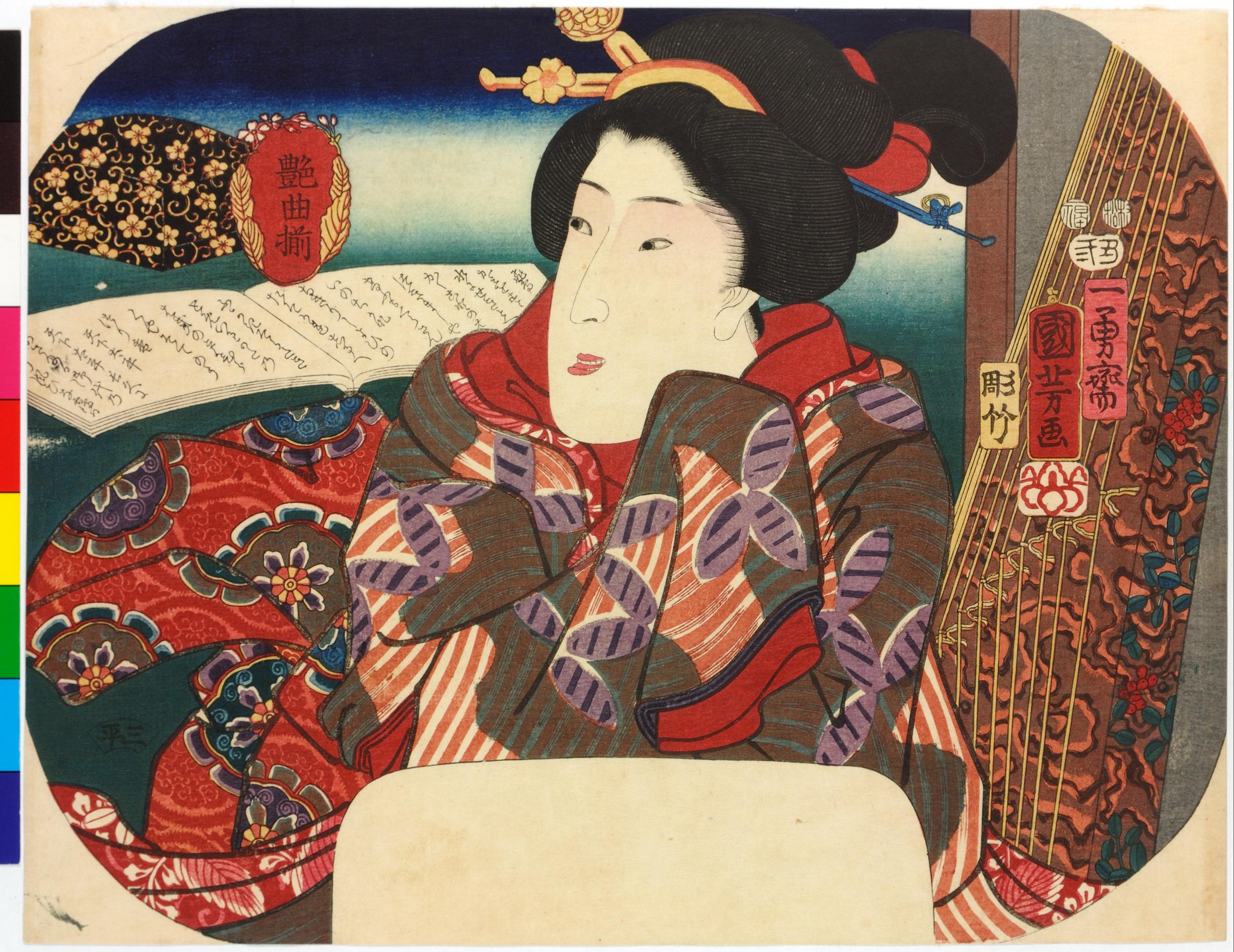-
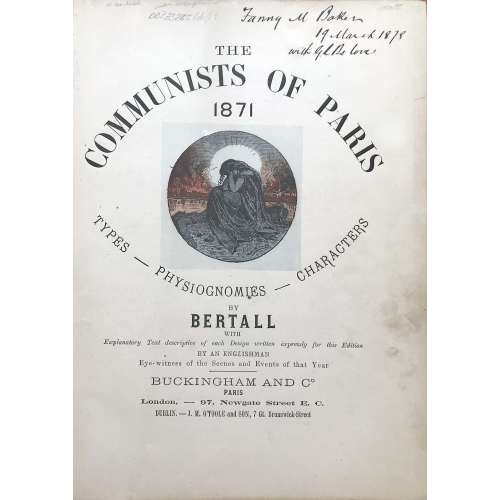 Folio (246 x 321 mm), hardbound in red-brown cloth with gilt lettering and decoration. Content, Introduction by J. E., September, 1873, Artist preface by Bertall, Paris, 1871-1873. Album with 40 hand-colored lithographs by Bertall, numbered 1 through 40, accompanied with extensive descriptions. Ex Libris: Baker. Carpe Diem. Markings: Janny M. Baker with J.L.B. Love, 19 March, 1878 in black ink.
Folio (246 x 321 mm), hardbound in red-brown cloth with gilt lettering and decoration. Content, Introduction by J. E., September, 1873, Artist preface by Bertall, Paris, 1871-1873. Album with 40 hand-colored lithographs by Bertall, numbered 1 through 40, accompanied with extensive descriptions. Ex Libris: Baker. Carpe Diem. Markings: Janny M. Baker with J.L.B. Love, 19 March, 1878 in black ink. -
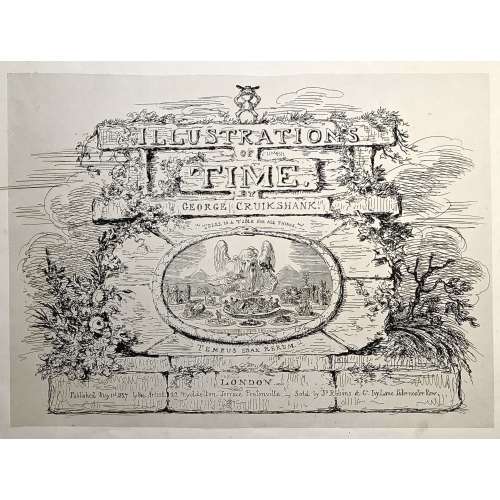
Engraved title page: ILLUSTRATION | OF | TIME. | GEORGE CRUIKSHANK. | "THERE IS A TIME FOR ALL THINGS". | TEMPUS EDAX RERUM. | LONDON | Published May 1st 1827 by the Artist - 22 Myddelton Terrace Pentonville. - Sold by Js. Robins & Co. Ivy Lane Paternoster Row.
Oblong folio, 33.5 x 44 cm. Engraved vignette title page and six not-coloured engraved plates with multiple images showing thirty-five humorous scenes.
First edition, first issue. Uncoloured. Pristine condition.
Half-leather bound in marbled cardboard and red morocco and gild lettering and arabesque. Frontispiece and 6 plates with protective tissues.
Content:1. Time-Called & Time-Come (five sketches)
2. Behind Time (seven sketches)
3. Time Thrown Away (six sketches)
4. Hard Times [&] Term Time (five sketches)
5. Time Badly Employed (five sketches)
6. Christmas Time (seven sketches)
British Museum № 1978,U.3026.1. BM description: "Frontispiece, the title on a background of symmetrical but dilapidated and grass-grown masonry. On the summit stands a little laughing gnome, with a wide hat and a body formed of an hour-glass; Inset is an oval bordered by a serpent with its tail in its mouth (emblem of eternity), in which is an aged and all-devouring Time (bald except for a forelock), seated behind a table whose surface is the base of the design. He puts to his mouth a fork on which is speared an elephant with a castle on its back containing tiny figures with spears. In his r. hand is a spoon containing a country church. His table is covered with dishes, and at his r. hand is a sickle. The central and biggest dish is heaped with a jumble of tiny objects: crown, table, chair, wheelbarrow, picture; round the room sit little figures: a soldier, parson, lady and child, &c. The ten other dishes contain: an antique glass coach with horses and footmen; an overladen camel beside a palm-tree; ruins of a castle; a farmhouse; a shepherd and sheep; a dismantled cannon and balls, cattle, a man-of-war in full sail; a ruinous Gothic cathedral; a clump of trees (the last two are dominated by a large decanter). Below Time are two (Egyptian) pyramids. Above: 'There Is A Time For All Things'; below: 'Tempus Edax Rerum'. 1 May 1827. Etching."Bibliography:- Reid, G W, A descriptive catalogue of the works of George Cruikshank, London, 1871.
- Stephens, Frederic George; George, Mary Dorothy, Catalogue of Political and Personal Satires in the Department of Prints and Drawings in the British Museum, 11 vols, London, BMP, 1870.
- Cohn, A M, George Cruikshank, catalogue raisonné, London, 1924.
-
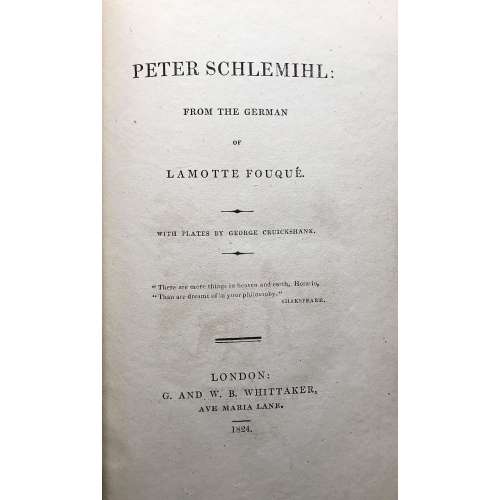 Title: PETER SCHLEMIHL: | FROM THE GERMAN | OF LAMOTTE FOUQUÉ | WITH PLATES BY GEORGE CRUICKSHANK. | "There are more things in heaven and earth, Horatio, | "Than are dreamt of in your philosophy." | SHAKESPEARE. | — | LONDON: | G. AND W. B. WHITTAKER, | AVE MARIA LANE. | 1824.|| Pagination: xii, 165 p. : ill. No Adelbert von Chamisso (German, 1781 – 1838) name on the title page. George Cruikshank's name printed with a typo 'Cruickshank'. The attribution on the title-page to Friedrich de La Motte-Fouqué (German, 1777 – 1843) is erroneous. The original German was edited by La Motte Fouqué. The translation was performed by Sir John Bowring (British, 1792 – 1872) First edition in English, third issue with no hyphen between "Ave" and 'Maria" in publisher's imprint.
Title: PETER SCHLEMIHL: | FROM THE GERMAN | OF LAMOTTE FOUQUÉ | WITH PLATES BY GEORGE CRUICKSHANK. | "There are more things in heaven and earth, Horatio, | "Than are dreamt of in your philosophy." | SHAKESPEARE. | — | LONDON: | G. AND W. B. WHITTAKER, | AVE MARIA LANE. | 1824.|| Pagination: xii, 165 p. : ill. No Adelbert von Chamisso (German, 1781 – 1838) name on the title page. George Cruikshank's name printed with a typo 'Cruickshank'. The attribution on the title-page to Friedrich de La Motte-Fouqué (German, 1777 – 1843) is erroneous. The original German was edited by La Motte Fouqué. The translation was performed by Sir John Bowring (British, 1792 – 1872) First edition in English, third issue with no hyphen between "Ave" and 'Maria" in publisher's imprint.In a cover box of red cloth over cardboard. Box: 21 x 13 x 2.3 cm; book: 19.3 x 11.8 x 1.7 cm; Crown 8vo. Red cardboard binding. Printed spine labels mounted on spine of the box and the book. Untrimmed edges.
Reference: Cohn 475. -
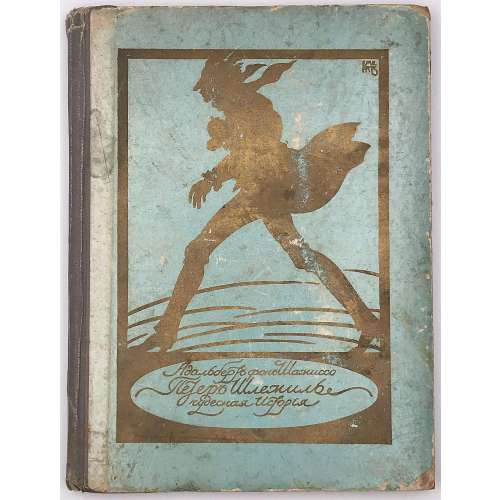
Шамиссо, Адальбертъ фонъ. Петеръ Шлемиль. Чудесная исторiя. Пер. П.Потемкина. Рис., виньетки и перепет Эмиля Преторiуса по 1-му нѣм. изд. 1814 г. — СПб.: Книгоиздательство "Пантеонъ", 1910. — 107 стр. Отпечатано в типографии акц. о-ва типографск. дела в СПБ (Герольд), 7 рота, 26.
Cardboard binding, 8vo, 20 x 15 cm. Russian translation of Adelbert von Chamisso book Peter Schlemihl, from the German by Peter Potemkine. With illustrations from 1814 original German first edition by Emil Preetorius. [SV: the latest statement seems strange as Emil Preetorius lived from 1883 to 1973]. -
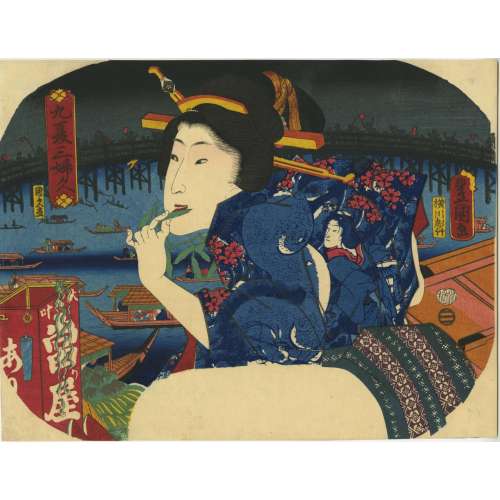 Untrimmed fan print (uchiwa-e), 231 x 300 mm. Title: A geisha eating edamame aboard the boat of the Atari-ya teahouse. Series: Three summer women [九夏三婦久] (Kyūka sanfuku). Artist: Utagawa Kunisada [歌川 国貞] a.k.a. Utagawa Toyokuni III [三代歌川豊国] (Japanese, 1786 – 1865). Artist: Utagawa Kunihisa II [歌川国久] a.k.a. Katsuda Hisatarō, Ichiunsai, Ritchōrō, Toyonobu, Yōryūsai, Yōsai] (Japanese, 1832 – 1981). Block cutter: Yokokawa Horitake [横川彫武] a.k.a. Yokokawa Takejiro [横川竹二郎] (Japanese, fl. 1860s). Publisher: Ibaya Senzaburō [伊場屋仙三郎] (Japanese, fl. C. 1845 – 1847) Combined date seal and kiwame censor seal: 1860 (Ansei 7 / Man'en 1 from 18/III). Signed: Toyokuni ga in toshidama cartouche, and Kunihisa ga. Provenance: The Collection of Paul F. Walter, Christie's, New York, 2017, lot 341; sol together with 5 other fan prints for $25,000. Before: Israel Goldman, Japanese Prints, Catalogue 9, 2003, no. 35. Ref: [LIB-1693.2018] The Collection of Paul Walter. — NY: Christie's, 2017, p. 363. Ref: Israel Goldman, Catalogue 2018, № 52: "Utagawa Kunisada (1786-1865) and Utagawa Kunihisa II (1832-1891) A Geisha Eating Edamame Aboard the Boat of the Atari-ya Teahouse. From the series Kyuka sanfuku (Three Summer Women). 1860. Fan print. 22.7 x 29.6 cm. Provenance: Israel Goldman, Japanese Prints, Catalogue 9, 2003, no. 35. The Collection of Paul F. Walter, Christies, New York, 201, lot 341. Fine impression, colour and condition. The title is a pun on “kyuka sanpuku” meaning the hottest point of the summer. The background view is by Kunisada’s pupil Kunihisa."
Untrimmed fan print (uchiwa-e), 231 x 300 mm. Title: A geisha eating edamame aboard the boat of the Atari-ya teahouse. Series: Three summer women [九夏三婦久] (Kyūka sanfuku). Artist: Utagawa Kunisada [歌川 国貞] a.k.a. Utagawa Toyokuni III [三代歌川豊国] (Japanese, 1786 – 1865). Artist: Utagawa Kunihisa II [歌川国久] a.k.a. Katsuda Hisatarō, Ichiunsai, Ritchōrō, Toyonobu, Yōryūsai, Yōsai] (Japanese, 1832 – 1981). Block cutter: Yokokawa Horitake [横川彫武] a.k.a. Yokokawa Takejiro [横川竹二郎] (Japanese, fl. 1860s). Publisher: Ibaya Senzaburō [伊場屋仙三郎] (Japanese, fl. C. 1845 – 1847) Combined date seal and kiwame censor seal: 1860 (Ansei 7 / Man'en 1 from 18/III). Signed: Toyokuni ga in toshidama cartouche, and Kunihisa ga. Provenance: The Collection of Paul F. Walter, Christie's, New York, 2017, lot 341; sol together with 5 other fan prints for $25,000. Before: Israel Goldman, Japanese Prints, Catalogue 9, 2003, no. 35. Ref: [LIB-1693.2018] The Collection of Paul Walter. — NY: Christie's, 2017, p. 363. Ref: Israel Goldman, Catalogue 2018, № 52: "Utagawa Kunisada (1786-1865) and Utagawa Kunihisa II (1832-1891) A Geisha Eating Edamame Aboard the Boat of the Atari-ya Teahouse. From the series Kyuka sanfuku (Three Summer Women). 1860. Fan print. 22.7 x 29.6 cm. Provenance: Israel Goldman, Japanese Prints, Catalogue 9, 2003, no. 35. The Collection of Paul F. Walter, Christies, New York, 201, lot 341. Fine impression, colour and condition. The title is a pun on “kyuka sanpuku” meaning the hottest point of the summer. The background view is by Kunisada’s pupil Kunihisa." -
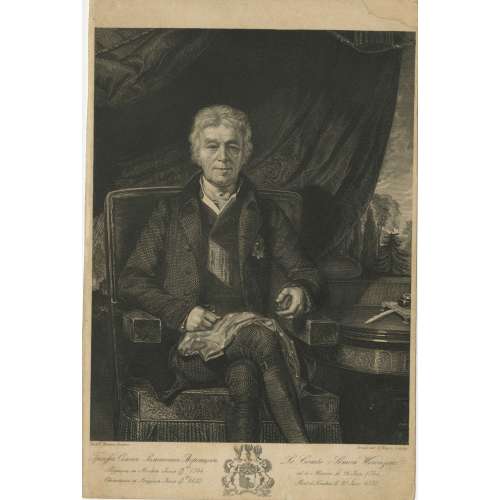
Seated portrait of Russian diplomat Count Semyon Romanovich Vorontsov (Семён Романович Воронцо́в; 26 June 1744 – 9 July 1832). Engraved by August Weger (Born: 1823 in Nürnberg; died: 1892 in Leipzig) from the portrait painted by Richard Evans (1784–1871). Circa 1825-50. Semyon Romanovich Vorontsov, the son of Count Roman Illarionovich and Marfa Ivanovna Surmina, was born on June 15, 1744; Active Privy Councillor; Ambassador to Venice and London from 1784, for over 20 years. Died in London on June 26, 1832.
Inscription: Графъ Семенъ Романовичь Воронцовъ. Родился въ Москвѣ Iюня 15-го/26 1744, Скончался въ Лондонѣ Iюня 9-го/21 1822. | Le Comte Simon Woronzow. né à Moscou le 26 Juin 1744, Mort à Londres le 21 Juin 1832. | Richd. Evans, Peintre. - Gravé par A. Weger, Leipzig. Vorontsov family coat of arms in the middle.
Dimensions: 23 x 15 cm. Ref.: Подробный словарь русских гравированных портретов Д. А. Ровинского, том. 1, 534-540. -
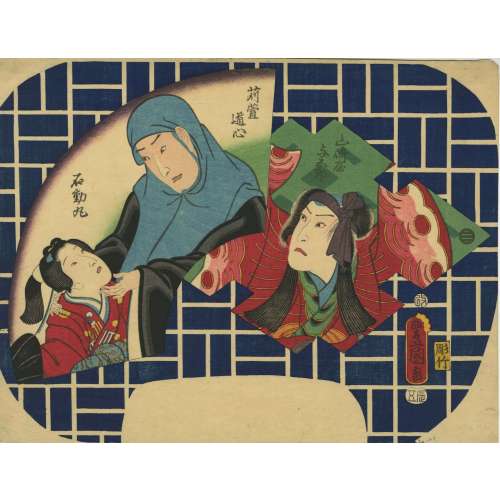 Utagawa Kunisada [歌川 国貞]; a.k.a. Utagawa Toyokuni III [三代歌川豊国] (Japanese, 1786 – 1865). Signed: Toyokuni ga [豊国 画] in a red toshidama cartouche. Publisher: Ibaya Senzaburō [伊場屋仙三郎] (Japanese, fl. 1815 – 1869). Block carver: Yokokawa Takejirō [横川竹二郎] (Japanese, fl. 1845 – 1863), seal: 彫竹 – Hori Take. Date seal and aratame censor seal: May of the Year of Dragon [辰五] (Tatsu-go) (5/1856) (Not in Marks).
Utagawa Kunisada [歌川 国貞]; a.k.a. Utagawa Toyokuni III [三代歌川豊国] (Japanese, 1786 – 1865). Signed: Toyokuni ga [豊国 画] in a red toshidama cartouche. Publisher: Ibaya Senzaburō [伊場屋仙三郎] (Japanese, fl. 1815 – 1869). Block carver: Yokokawa Takejirō [横川竹二郎] (Japanese, fl. 1845 – 1863), seal: 彫竹 – Hori Take. Date seal and aratame censor seal: May of the Year of Dragon [辰五] (Tatsu-go) (5/1856) (Not in Marks).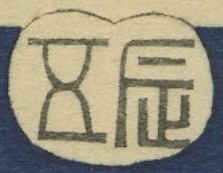 Uncut fan print (uchiwa-e) depicting Onoe Kikugorō IV as Karukaya Dōshin parting from his son, Ishidomaru (played by Ichimura Uzaemon XIII), and Kawarasaki Gonjūrō I as Yamazakiya Yogoro in the kabuki play Karukaya Dōshin Tsukushi no Iezuto [苅萱桑門筑紫𨏍], written by Namiki Sōsuke [並木宗輔] (Japanese, 1695 – 1751) and performed at Ichimuraza [市村座] in 05/1856.
Media: Fan print [団扇絵] (Uchiwa-e); size: 235 x 305 mm.
Actors:
Onoe Kikugorō IV [四代目 尾上菊五郎] (Japanese, 1808 – 1860); other names: Onoe Baikō IV, Onoe Eizaburō III, Onoe Kikue, Nakamura Tatsuzō, Nakamura Kachō.
Onoe Kikugorō V [五代目尾上菊五郎] (Japanese, 1844 – 1903 other names: Onoe Baikō V, Ichimura Kakitsu IV, Ichimura Uzaemon XIII [十三代目市村羽左衛門], Ichimura Kurōemon.
Ichikawa Danjūrō IX [市川団十郎] (Japanese, 1838 – 1903); other names: Kawarasaki Sanshō, Kawarasaki Gonnosuke VII, Kawarasaki Gonjūrō I, Kawarasaki Chōjūrō III.
Plot: It was a popular belief at one time that jealous women had their hair transformed into writhing serpents and Kato Sayemon Shige-Uji, a daimyo of Tsukushi, a much-married man, suffered from the delusion that his wife was so affected. He fled to the mountains to escape her and led the life of a hermit under the name of Karukaya Doshin [苅萓道心]. One day, on Mount Kōya (高野山, Kōyasan) Karukaya meets a young man who was wandering in the mountains. Being questioned, the youth tells his name, Ishidomaru, and elicits the information that he is seeking his lost father. Karukaya then recognizes the boy as his own son, but firm in the resolve to remain lost to the world, he refrains from disclosing himself, and bids the youth return home.
Provenance: Paul F. Walter (American, 1935 – 2017).
Ref.:
Uncut fan print (uchiwa-e) depicting Onoe Kikugorō IV as Karukaya Dōshin parting from his son, Ishidomaru (played by Ichimura Uzaemon XIII), and Kawarasaki Gonjūrō I as Yamazakiya Yogoro in the kabuki play Karukaya Dōshin Tsukushi no Iezuto [苅萱桑門筑紫𨏍], written by Namiki Sōsuke [並木宗輔] (Japanese, 1695 – 1751) and performed at Ichimuraza [市村座] in 05/1856.
Media: Fan print [団扇絵] (Uchiwa-e); size: 235 x 305 mm.
Actors:
Onoe Kikugorō IV [四代目 尾上菊五郎] (Japanese, 1808 – 1860); other names: Onoe Baikō IV, Onoe Eizaburō III, Onoe Kikue, Nakamura Tatsuzō, Nakamura Kachō.
Onoe Kikugorō V [五代目尾上菊五郎] (Japanese, 1844 – 1903 other names: Onoe Baikō V, Ichimura Kakitsu IV, Ichimura Uzaemon XIII [十三代目市村羽左衛門], Ichimura Kurōemon.
Ichikawa Danjūrō IX [市川団十郎] (Japanese, 1838 – 1903); other names: Kawarasaki Sanshō, Kawarasaki Gonnosuke VII, Kawarasaki Gonjūrō I, Kawarasaki Chōjūrō III.
Plot: It was a popular belief at one time that jealous women had their hair transformed into writhing serpents and Kato Sayemon Shige-Uji, a daimyo of Tsukushi, a much-married man, suffered from the delusion that his wife was so affected. He fled to the mountains to escape her and led the life of a hermit under the name of Karukaya Doshin [苅萓道心]. One day, on Mount Kōya (高野山, Kōyasan) Karukaya meets a young man who was wandering in the mountains. Being questioned, the youth tells his name, Ishidomaru, and elicits the information that he is seeking his lost father. Karukaya then recognizes the boy as his own son, but firm in the resolve to remain lost to the world, he refrains from disclosing himself, and bids the youth return home.
Provenance: Paul F. Walter (American, 1935 – 2017).
Ref.:
- [LIB-2110.2019] Samuel L. Leiter. Historical Dictionary of Japanese Traditional Theatre (Historical Dictionaries of Literature and the Arts). / 2nd edition. – Lanham: Rowman & Littlefield, 2014; pp. 379-380.
- [LIB-2206.2019] Basil Stewart. Subjects portrayed in Japanese colour-prints. — London: Kegan Paul, Trench, Trubner & Co. Ltd., 1922.
-
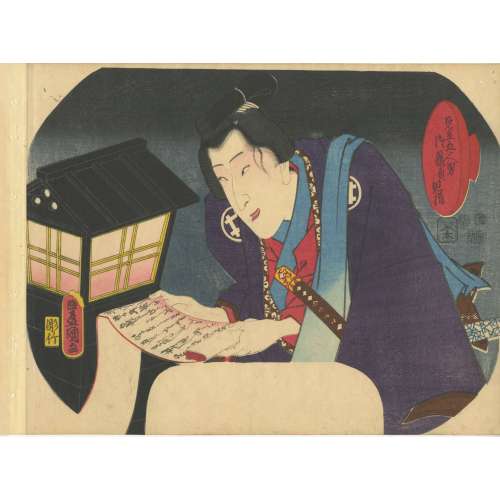 Utagawa Kunisada [歌川 国貞] a.k.a. Utagawa Toyokuni III [三代歌川豊国] (Japanese, 1786 – 1865).
Utagawa Kunisada [歌川 国貞] a.k.a. Utagawa Toyokuni III [三代歌川豊国] (Japanese, 1786 – 1865).Uncut fan print (uchiwa-e), 295 x 230 mm, depicting kabuki actor Bandō Shūka I as Shirai Gonpachi (白井権八) reading a scroll by the light of a lantern. From the series A Parody of the Five Chivalrous Commoners; a Cup of Sake From Their Fans (Mitate gonin otoko, go-hiiki no omoizashi). According to Paul Griffith, the term omoizashi refers to the act of pouring a cup of sake for one's chosen partner, here giving an impression of intimacy and affection between famous actors and their patrons.
Actor: Bandō Shūka I [初代坂東しうか] (Japanese, 1813-1855); other names: Bandō Tamasaburō I, Bandō Mitsugorō V (posthumously). The print was probably published by some unknown Yama-Ta (Marks U421b). Double nanushi censor seals and date seal: Muramatsu and Fuku, Kaei 5, 2nd month (2/1852). As Kabuki Encyclopedia put it: "Gonpachi. A parasite. From the character named Shirai Gonpachi who lives at the home of Banzui Chōbei and sponges off him" (An English-Langauge Adaptation of Kabuki Jiten. Samuel L. Leiter. Greenwood Press, 1979, pp. 26, 98-9). There were many kabuki plays based on the story of the lovers Miura-ya Komurasaki and Shirai Gonpachi. (See: [LIB-2226.2019] Algernon Bertram Freeman-Mitford. Tales of Old Japan. — London: Macmillan and Co., 1883). Ref.: Art shop Ezoshi Ukiyoe new collection news, vol. 66, 2023.1 (Jan) # 31, p.8. -
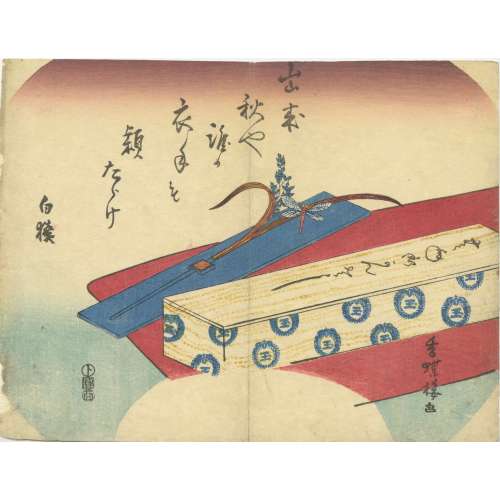 Utagawa Kunisada [歌川 国貞] a.k.a. Utagawa Toyokuni III [三代歌川豊国] (Japanese, 1786 – 1865)
Utagawa Kunisada [歌川 国貞] a.k.a. Utagawa Toyokuni III [三代歌川豊国] (Japanese, 1786 – 1865)Promotional fan for a hairpin shop, with a poem by Ichikawa Danjuro VII, signed Hakuen.
Date seal plus rectangular kiwame seal: Bunsei 8 (1825).
Size: Fan print. Uchiwa-e (27.5 x 21.1 cm) Publisher seal: Maru-To (2) (Marks U204). Date seal plus rectangular kiwame seal: Bunsei 8 (1825). -
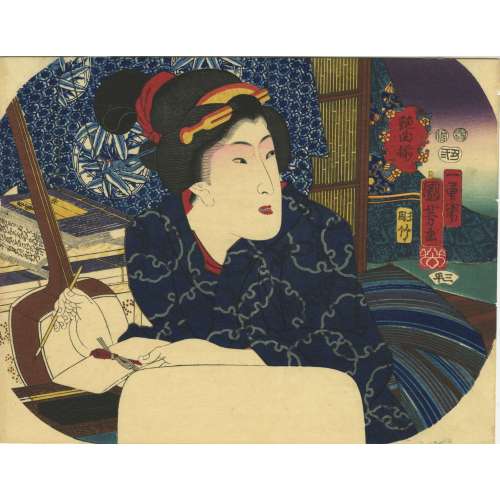 Artist: Utagawa Kuniyoshi [歌川 國芳] (Japanese, 1798 – 1861) Publisher: British Museum provides for the title as Enkyoku-zoroi [艶曲揃] (Set of Voluptuous Melodies) and the publisher as Sanpei. Indeed, 三平 (Sanpei) was a wholesale fan shop at the end of the Edo period. However, Andreas Marks identifies the publisher's seal as 三平 Mihei = Mikawaya Heiroku (1848-56), a member of the Fan Producing Guild (AM 11-016|325a). Block carver: Yokokawa Takejirō, seal: Carver Taki [彫竹] (Hori Take)
Artist: Utagawa Kuniyoshi [歌川 國芳] (Japanese, 1798 – 1861) Publisher: British Museum provides for the title as Enkyoku-zoroi [艶曲揃] (Set of Voluptuous Melodies) and the publisher as Sanpei. Indeed, 三平 (Sanpei) was a wholesale fan shop at the end of the Edo period. However, Andreas Marks identifies the publisher's seal as 三平 Mihei = Mikawaya Heiroku (1848-56), a member of the Fan Producing Guild (AM 11-016|325a). Block carver: Yokokawa Takejirō, seal: Carver Taki [彫竹] (Hori Take)Signed: Ichiyosai Kuniyoshi ga in a red cartouche and sealed with paulownia (kiri mon).
Date seal and double nanushi censor seals: Fuku & Muramatsu, 1853 (Kaei 6, 2nd month).
Size: Uchiwa-e (untrimmed fan print) 296 x 230 mm.
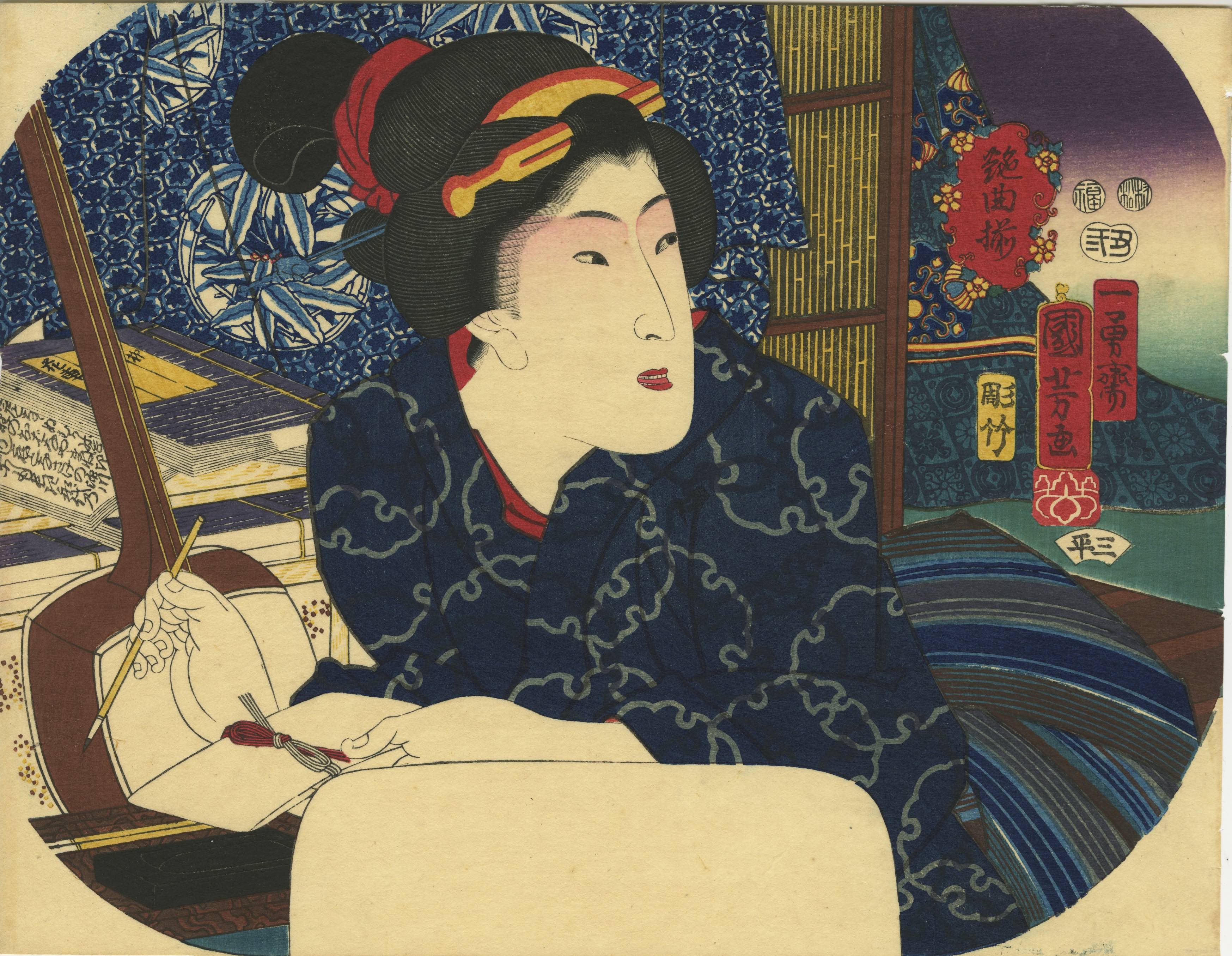
SVJP-0303.2019
-
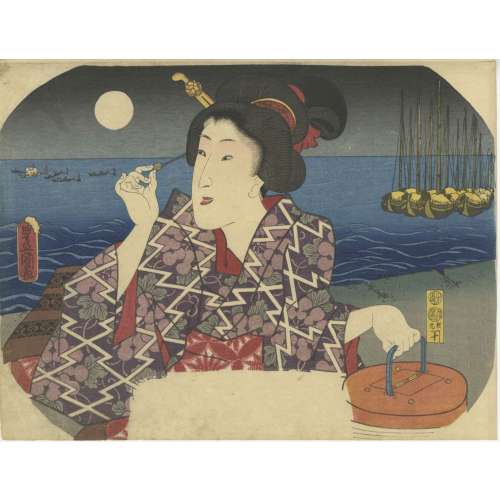 Utagawa Kunisada [歌川 国貞]; a.k.a. Utagawa Toyokuni III [三代歌川豊国] (Japanese, 1786 – 1865).
Utagawa Kunisada [歌川 国貞]; a.k.a. Utagawa Toyokuni III [三代歌川豊国] (Japanese, 1786 – 1865).Signed: Toyokuni ga [豊国 画] in a red toshidama cartouche.
Publisher: Kojimaya Jūbei (c. 1797-1869), seal: Hanmoto, Jū [板元, 十] (Marks 19-043 | 264c).
Double nanushi censor seals: Mera & Watanabe – Kaei 4 (1851).
Uncut fan print (uchiwa-e), 298 x 228 mm depicting a young woman adjusting her hairpin and holding a portable lantern (andon) on a marine background with the full moon, nearby boats and distant cormorant fishers. -
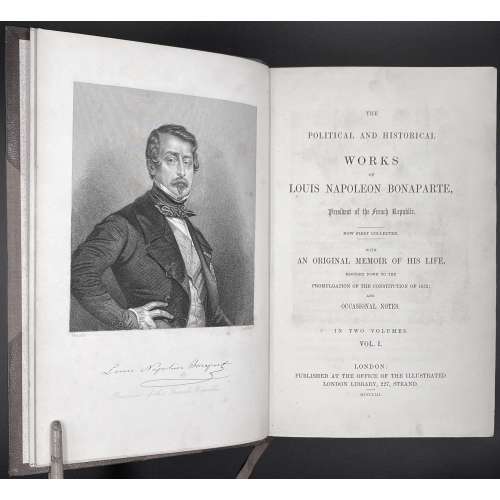 [Bonaparte, Louis Napoleon]. The Political and Historical Works of Louis Napoleon Bonaparte, President of the French Republic, Now First Collected With An Original Memoir of His Life, Brought Down to the Promulgation of the Constitution of 1852; and Occasional Notes, Complete in Two Volumes. London: Illustrated London Library, MDCCCLII [1852]. Collation: Vol. 1: [i-v] vi [vii-viii (blank)] [1] 2-462 [463,464 (blank)]; Vol. 2: [1-3] 4-439 [440]. Size: 22.8 x 14.8 cm (8vo), each. Binding: hardcover; half red morocco and cloth boards, five raised bands, gilt title and decoration, top edge gilt. Frontispiece portrait of Louis Napoleon Bonaparte in Vol. 1. Condition: Very good, rubbing to outer joints, leather corners, faint foxing to endpapers, ownership signature on half-title. Internally bright and unmarked. In binding by Brentano's, New York.
[Bonaparte, Louis Napoleon]. The Political and Historical Works of Louis Napoleon Bonaparte, President of the French Republic, Now First Collected With An Original Memoir of His Life, Brought Down to the Promulgation of the Constitution of 1852; and Occasional Notes, Complete in Two Volumes. London: Illustrated London Library, MDCCCLII [1852]. Collation: Vol. 1: [i-v] vi [vii-viii (blank)] [1] 2-462 [463,464 (blank)]; Vol. 2: [1-3] 4-439 [440]. Size: 22.8 x 14.8 cm (8vo), each. Binding: hardcover; half red morocco and cloth boards, five raised bands, gilt title and decoration, top edge gilt. Frontispiece portrait of Louis Napoleon Bonaparte in Vol. 1. Condition: Very good, rubbing to outer joints, leather corners, faint foxing to endpapers, ownership signature on half-title. Internally bright and unmarked. In binding by Brentano's, New York. -
 A two-volume set: (1) Thomas Hugo. The Bewick Collector. A Descriptive Catalogue of the Works of Thomas and John Bewick; Including cuts, in various states, for Books and Pamphlets, Private Gentlemen, Public Companies, Exhibitions, Races, Newspapers, Shop Cards, Invoice Heads, Bar Bills, Coal Certificates, Broadsides, and other miscellaneous purposes, and Wood Blocks. With an Appendix of Portraits, Autographs, Works of Pupils, etc., etc. The whole described from the Originals contained in the largest and most perfect collection ever formed, and illustrated with a hundred and twelve cuts. — London: Lovell Reeve and Co., MDCCCLXVI [1866]. — [Printed by] J. E. Taylor and Co., printers. — pp.: [i-v] vi-xxiii [xxiv], [1] 2-562. (2) Thomas Hugo. The Bewick Collector. A Supplement to a Descriptive Catalogue of the Works of Thomas and John Bewick; Consisting of additions to the various divisions of cuts, wood blocks. etc., enumerated in that work. The whole described from the Originals contained in the largest and most perfect collection ever formed, and illustrated with a hundred and eighty cuts. — London: L. Reeve and Co, MDCCCLXVIII [1868]. — [Printed by] J. E. Taylor and Co., printers. — pp.: [i-vii] viii-xxxii, [1] 2-353. Both volumes in 8vo, 22.5 x 14.5 cm, hardcover. Contemporary dark brown half morocco, gilt-ruled, with 5 raised bands, gilt titles and decoration to spine, and marbled paper over boards. Top edge gilt; marbled endpapers. Binding splitting at pp.80/81 of the 1st volume. Armorial bookplate of Ralph Hart Tweddle to front pastedown. Ralph Hart Tweddle (1843 – 1895) was a British mechanical engineer, known particularly for inventing the portable hydraulic riveter, which greatly facilitated the construction of boilers, bridges and ships.
A two-volume set: (1) Thomas Hugo. The Bewick Collector. A Descriptive Catalogue of the Works of Thomas and John Bewick; Including cuts, in various states, for Books and Pamphlets, Private Gentlemen, Public Companies, Exhibitions, Races, Newspapers, Shop Cards, Invoice Heads, Bar Bills, Coal Certificates, Broadsides, and other miscellaneous purposes, and Wood Blocks. With an Appendix of Portraits, Autographs, Works of Pupils, etc., etc. The whole described from the Originals contained in the largest and most perfect collection ever formed, and illustrated with a hundred and twelve cuts. — London: Lovell Reeve and Co., MDCCCLXVI [1866]. — [Printed by] J. E. Taylor and Co., printers. — pp.: [i-v] vi-xxiii [xxiv], [1] 2-562. (2) Thomas Hugo. The Bewick Collector. A Supplement to a Descriptive Catalogue of the Works of Thomas and John Bewick; Consisting of additions to the various divisions of cuts, wood blocks. etc., enumerated in that work. The whole described from the Originals contained in the largest and most perfect collection ever formed, and illustrated with a hundred and eighty cuts. — London: L. Reeve and Co, MDCCCLXVIII [1868]. — [Printed by] J. E. Taylor and Co., printers. — pp.: [i-vii] viii-xxxii, [1] 2-353. Both volumes in 8vo, 22.5 x 14.5 cm, hardcover. Contemporary dark brown half morocco, gilt-ruled, with 5 raised bands, gilt titles and decoration to spine, and marbled paper over boards. Top edge gilt; marbled endpapers. Binding splitting at pp.80/81 of the 1st volume. Armorial bookplate of Ralph Hart Tweddle to front pastedown. Ralph Hart Tweddle (1843 – 1895) was a British mechanical engineer, known particularly for inventing the portable hydraulic riveter, which greatly facilitated the construction of boilers, bridges and ships. -
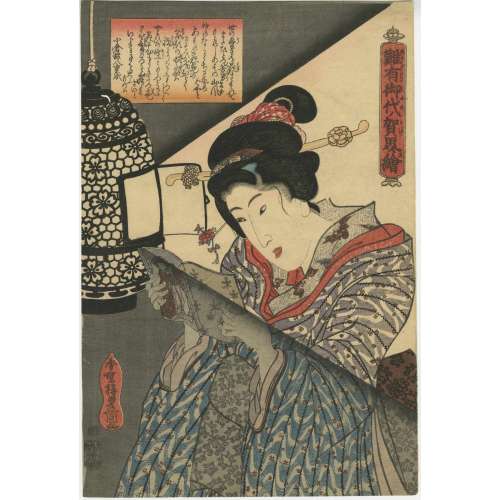 Utagawa Kunisada (Japanese: 歌川 国貞; also known as Utagawa Toyokuni III (三代歌川豊国); 1786 – 12 January 1865).
Utagawa Kunisada (Japanese: 歌川 国貞; also known as Utagawa Toyokuni III (三代歌川豊国); 1786 – 12 January 1865).A young woman reading a book in the light of a lamp. Series: Arigataki miyo no kage-e (Shadow Pictures of an Auspicious Age). There are five known prints, half-length portraits of beauties, in this series, designed by Kunisada in ca. 1844. Another print from the series in this collection: SVJP-0306.2020: A young woman adjusting her hairpins in the light of a paper lantern.
Signed: Kōchōrō Toyokuni ga (香蝶楼豊国画).
Publisher: Maruya Kiyojiro.
Size: Vertical Ōban (37.5 x 25.4 cm). -
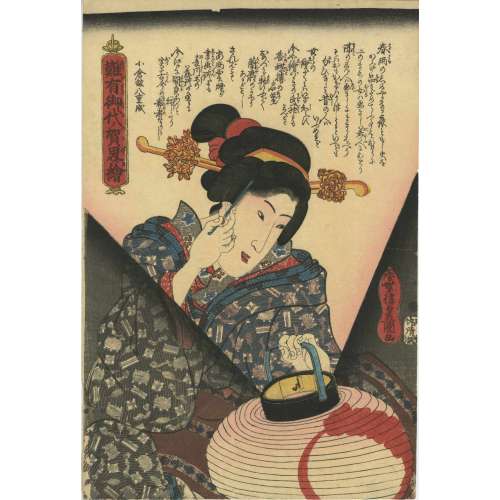 Utagawa Kunisada (Japanese: 歌川 国貞; also known as Utagawa Toyokuni III (三代歌川豊国); 1786 – 12 January 1865).
Utagawa Kunisada (Japanese: 歌川 国貞; also known as Utagawa Toyokuni III (三代歌川豊国); 1786 – 12 January 1865).A young woman adjusting her hairpins in the light of a paper lantern. Series: Arigataki miyo no kage-e (Shadow Pictures of an Auspicious Age). There are five known prints, half-length portraits of beauties, in this series, designed by Kunisada in ca. 1844. Another print from the series in this collection: SVJP-0309.2020: A young woman reading a book in the light of a lamp.
Signed: Kōchōrō Toyokuni ga (香蝶楼豊国画). Publisher: Maruya Kiyojiro.
Size: Vertical Ōban (37.5 x 25.4 cm). Utagawa (歌川) SOLD -
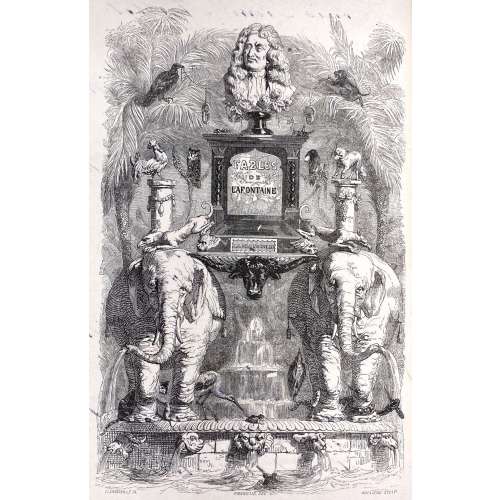 Fables de La Fontaine / édition illustrée par J. J. Grandville (in 2 volumes). – Paris: H. Fournier Ainé, Perronin, 1838. Imp. H. Fournier et Ce, 14 rue de Seine (Premier Tirage). Vol 1: [2 - ht, imprim.] [2 - blank with handwritten inscription, frontis.] [2 - t.p., blank], [ [i] ii-xxviii - épitre, préface, [2 - plate 'fables', [1] 2 - dedication, [3, 4 - pltate: livre 1, blank] [5, 6 - plate: blank, cigale] [7] 8 - fab.1 (the subsequent plates are not paginated) - 292. (245-246 - Avertissement), (247-248 - A mamdam de Montespan); Wood engravings: frontispiece + half-title Fables + 7 running half-titles Livres des Fables + 72 plates. Vol. 2: [2 - ht, imprim.] [2 - t.p., blank] [1, 2 - plate 'livre 8', blank] [3] 4-312 (191-192 épilogue), (195-196 Au duc de Bourgogne), (268 - fin des fables), (269-296 Philemon et Baucis | D. O. M. | La Martone Déphèse | Belphegor), (297 -308 notice), (309-312 table); Wood engravings: 5 running half-titles Livres des Fables + 1 half-title Philemon et Baucis + 48 plates. Size: 8vo, 23.2 x 15 cm. Binding: Full tree-calf, flat spine stamped with gilt, red and brown labels with gilt lettering, marbled endpapers. Handwritten nut ink inscription to blank recto of frontispiece: the history of Millet-Fontaine family (provenance?) There were two print-runs in the year 1838. According to Léopold Carteret (Le trésor du bibliophile. Epoque romantique. 1801-1875 / Livres illustrés du XIXe siècle. – Paris: L. Carteret; imprim. Lahure, 1927, pp. 357-9), the first run (Premier Tirage) published by H. Fournier and Perrotin, while the Second Tirage by H. Fournier Ainé. Though, the initial cap character "N" at p. xiii (vie d'Ésope) in this copy is formed by 'faite de lignes bouclées' as in the first print-run, rather than by 'petits carreaux noirs et blances' as in the second. We can conclude with confidence that this copy belongs to Premier Tirage.
Fables de La Fontaine / édition illustrée par J. J. Grandville (in 2 volumes). – Paris: H. Fournier Ainé, Perronin, 1838. Imp. H. Fournier et Ce, 14 rue de Seine (Premier Tirage). Vol 1: [2 - ht, imprim.] [2 - blank with handwritten inscription, frontis.] [2 - t.p., blank], [ [i] ii-xxviii - épitre, préface, [2 - plate 'fables', [1] 2 - dedication, [3, 4 - pltate: livre 1, blank] [5, 6 - plate: blank, cigale] [7] 8 - fab.1 (the subsequent plates are not paginated) - 292. (245-246 - Avertissement), (247-248 - A mamdam de Montespan); Wood engravings: frontispiece + half-title Fables + 7 running half-titles Livres des Fables + 72 plates. Vol. 2: [2 - ht, imprim.] [2 - t.p., blank] [1, 2 - plate 'livre 8', blank] [3] 4-312 (191-192 épilogue), (195-196 Au duc de Bourgogne), (268 - fin des fables), (269-296 Philemon et Baucis | D. O. M. | La Martone Déphèse | Belphegor), (297 -308 notice), (309-312 table); Wood engravings: 5 running half-titles Livres des Fables + 1 half-title Philemon et Baucis + 48 plates. Size: 8vo, 23.2 x 15 cm. Binding: Full tree-calf, flat spine stamped with gilt, red and brown labels with gilt lettering, marbled endpapers. Handwritten nut ink inscription to blank recto of frontispiece: the history of Millet-Fontaine family (provenance?) There were two print-runs in the year 1838. According to Léopold Carteret (Le trésor du bibliophile. Epoque romantique. 1801-1875 / Livres illustrés du XIXe siècle. – Paris: L. Carteret; imprim. Lahure, 1927, pp. 357-9), the first run (Premier Tirage) published by H. Fournier and Perrotin, while the Second Tirage by H. Fournier Ainé. Though, the initial cap character "N" at p. xiii (vie d'Ésope) in this copy is formed by 'faite de lignes bouclées' as in the first print-run, rather than by 'petits carreaux noirs et blances' as in the second. We can conclude with confidence that this copy belongs to Premier Tirage.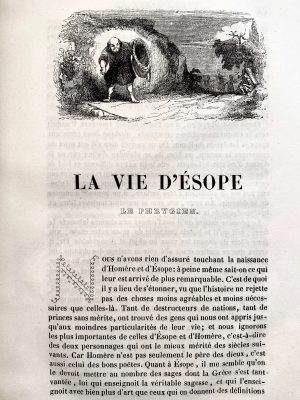 Wood engravings (135 plates, including frontispiece, and numerous headpieces and initial letters) were cut by the following artists (the first number is the number of the chapter ('livre'), the second – the number of the fable within the 'livre':
Wood engravers:
John Bastin, (British, fl. 1840 – 1850): 6-6, 7-13, and 8-9.
Alexandre Belhatte (French, born in 1811): 3-11 and chapter title pages to 'livres' 6, 11, 12, headpices on p. 117 in vol. 2, and 'Philemon et Baucis' section title page.
J. Constantine Beneworth (active France, 19th century): 1-6.
Louis-Henri Brévière (French, 1797 – 1869): 1-10, 2-7, 6-10, 6-21, 7-4, 8-10, 8-27, 9-3, 10-4, 12-11, frontispice, together with François-Louis Français (French, 1814–1897), and 'Fin des fables' tailpiece.
Brévière et Hébert: Louis-Henri Brévière (French, 1797 – 1869) and César-Auguste Hébert (French, active 19th century): 1-1, 1-2, 1-13, 1-18, 2-2, 2-11, 3-1, 3-3, 3-4, 3-18, 4-20, 4-21, 4-22, 5-5, 5-20, 6-2, 6-8, 7-3, 8-7, 8-12, 8-14, 8-17, 9-14, 10-6, 10-16, 11-6, 12-4, 12-25.
Joseph-Hippolyte-Jules Caqué (French, 1814 – 1885): 7-11 and headpieces on p. 251 in vol. 1 and on p. 197 in vol. 2.
Prosper-Adolphe-Léon Cherrier (French, born 1806): 8-6.
Henry Isidore Chevauchet (French, fl. 1837 – 1850): 1-19, 2-4, and 4-5.
Louis Dujardin (French, 1808 – 1859): 10-9.
Pierre-François Godard (French, 1768 – 1838): 1-5, 1-16, 5-2, and 10-11.
Charles David Laing (British, fl. 1836 – 1853): 7-9.
Lacoste père et fils aîné et Auguste-Alexandre Guillaumot (French, 1815 – 1892): 1-4, 1-20, 9-17, and 11-5.
Laisné (Alfred, Adèle, and Aglaé) (French, active 1835–1868): 5-8, 6-5, 6-17, 8-2, 8-15, 9-9, 9-10, 11-1, 11-8, 12-10.
(Alfred, Adèle, and Aglaé) Laisné (French, active 1835–1868): 5-8, 6-5, 6-17, 8-2, 8-15, 9-9, 9-10, 11-1, 11-8, 12-10.
Théodore Maurisset (French, fl. 1834 – 1859): 2-14 and 6-13.
Antoine-Alphée Piaud (French, 1813 – 1867): 1-17, 2-9, 2-16, 4-1, 4-4, 5-15, 5-17, 5-18, 5-21, 8-22, 8-23, 8-25, 9-19, 10-13, 11-3, 11-9, 12-13, 12-15, 12-21, three 'livres': 3, 9, 10, and headpiece on p. 71 in vol. 2.
Roux-Jourdain: Two 'livre' title pages, 1 and 2.
John Orrin Smith (British, 1799 – 1843): 2-13, 2-18, 3-9, 3-14, 4-9, and 4-14.L. Chauchefoin (French): 2-3 and 5.13.
Matthew Urlwin Sears (British, 1799 – 1870): 10-1 and 12-9.
Monogram TM or MT (possibly for Théodore Maurisset): 6-16 and 10-3.
Monogram GO–> (possibly for Godard) : 5-3, 7-1, and 9-5.
Monogram B and BV: 4-11, 12-6, 'livre' 4, and headpieces on p. 1 in vol. 1 and on p. 167 in vol. 2.
Unsigned or with an illegible signature: "fables' section title, 1-3, 1-9, 3-5, 3-8, 4-15, 4-18, 5-10, 7-7, 7-16, 9-2, 9-4, 12-2, 12-3, 12-17, and two 'livre' title pages, 5 and 8.
Little is know about Matthew Urlwin Sears. He was a wood engraver of good reputation who is known to have worked in London in the early 1820s, Paris and Leipzig. Listed as "wood engraver" on records of the UK Printing Historical Society. Work The British Museum owns three of his earliest published works, engravings for Northcote's Fables (1828). He authored "Specimen of stereotype ornaments, 1825" which was reprinted as a facsimile in 1990 by the Printing Historical Society (London), with a foreword by James Mosley. He is mentioned by Pierre Gusman in "La Gravure sur Bois en France" (Paris, 1929). Laurent's Histoire de l'Empereur Napoleon, (1839) is one of many publications on which both Sears and his partner John Quartly worked, as well as numerous other engravers. His work appeared in "Aunt Effie's Rhymes" (1852) and "Uncle Tom's Cabin", by Harriet Beech Stowe (Edinburgh: Adam and Charles Black, 1853) [Claire-Juliette Beale, December 2009].
Wood engravings (135 plates, including frontispiece, and numerous headpieces and initial letters) were cut by the following artists (the first number is the number of the chapter ('livre'), the second – the number of the fable within the 'livre':
Wood engravers:
John Bastin, (British, fl. 1840 – 1850): 6-6, 7-13, and 8-9.
Alexandre Belhatte (French, born in 1811): 3-11 and chapter title pages to 'livres' 6, 11, 12, headpices on p. 117 in vol. 2, and 'Philemon et Baucis' section title page.
J. Constantine Beneworth (active France, 19th century): 1-6.
Louis-Henri Brévière (French, 1797 – 1869): 1-10, 2-7, 6-10, 6-21, 7-4, 8-10, 8-27, 9-3, 10-4, 12-11, frontispice, together with François-Louis Français (French, 1814–1897), and 'Fin des fables' tailpiece.
Brévière et Hébert: Louis-Henri Brévière (French, 1797 – 1869) and César-Auguste Hébert (French, active 19th century): 1-1, 1-2, 1-13, 1-18, 2-2, 2-11, 3-1, 3-3, 3-4, 3-18, 4-20, 4-21, 4-22, 5-5, 5-20, 6-2, 6-8, 7-3, 8-7, 8-12, 8-14, 8-17, 9-14, 10-6, 10-16, 11-6, 12-4, 12-25.
Joseph-Hippolyte-Jules Caqué (French, 1814 – 1885): 7-11 and headpieces on p. 251 in vol. 1 and on p. 197 in vol. 2.
Prosper-Adolphe-Léon Cherrier (French, born 1806): 8-6.
Henry Isidore Chevauchet (French, fl. 1837 – 1850): 1-19, 2-4, and 4-5.
Louis Dujardin (French, 1808 – 1859): 10-9.
Pierre-François Godard (French, 1768 – 1838): 1-5, 1-16, 5-2, and 10-11.
Charles David Laing (British, fl. 1836 – 1853): 7-9.
Lacoste père et fils aîné et Auguste-Alexandre Guillaumot (French, 1815 – 1892): 1-4, 1-20, 9-17, and 11-5.
Laisné (Alfred, Adèle, and Aglaé) (French, active 1835–1868): 5-8, 6-5, 6-17, 8-2, 8-15, 9-9, 9-10, 11-1, 11-8, 12-10.
(Alfred, Adèle, and Aglaé) Laisné (French, active 1835–1868): 5-8, 6-5, 6-17, 8-2, 8-15, 9-9, 9-10, 11-1, 11-8, 12-10.
Théodore Maurisset (French, fl. 1834 – 1859): 2-14 and 6-13.
Antoine-Alphée Piaud (French, 1813 – 1867): 1-17, 2-9, 2-16, 4-1, 4-4, 5-15, 5-17, 5-18, 5-21, 8-22, 8-23, 8-25, 9-19, 10-13, 11-3, 11-9, 12-13, 12-15, 12-21, three 'livres': 3, 9, 10, and headpiece on p. 71 in vol. 2.
Roux-Jourdain: Two 'livre' title pages, 1 and 2.
John Orrin Smith (British, 1799 – 1843): 2-13, 2-18, 3-9, 3-14, 4-9, and 4-14.L. Chauchefoin (French): 2-3 and 5.13.
Matthew Urlwin Sears (British, 1799 – 1870): 10-1 and 12-9.
Monogram TM or MT (possibly for Théodore Maurisset): 6-16 and 10-3.
Monogram GO–> (possibly for Godard) : 5-3, 7-1, and 9-5.
Monogram B and BV: 4-11, 12-6, 'livre' 4, and headpieces on p. 1 in vol. 1 and on p. 167 in vol. 2.
Unsigned or with an illegible signature: "fables' section title, 1-3, 1-9, 3-5, 3-8, 4-15, 4-18, 5-10, 7-7, 7-16, 9-2, 9-4, 12-2, 12-3, 12-17, and two 'livre' title pages, 5 and 8.
Little is know about Matthew Urlwin Sears. He was a wood engraver of good reputation who is known to have worked in London in the early 1820s, Paris and Leipzig. Listed as "wood engraver" on records of the UK Printing Historical Society. Work The British Museum owns three of his earliest published works, engravings for Northcote's Fables (1828). He authored "Specimen of stereotype ornaments, 1825" which was reprinted as a facsimile in 1990 by the Printing Historical Society (London), with a foreword by James Mosley. He is mentioned by Pierre Gusman in "La Gravure sur Bois en France" (Paris, 1929). Laurent's Histoire de l'Empereur Napoleon, (1839) is one of many publications on which both Sears and his partner John Quartly worked, as well as numerous other engravers. His work appeared in "Aunt Effie's Rhymes" (1852) and "Uncle Tom's Cabin", by Harriet Beech Stowe (Edinburgh: Adam and Charles Black, 1853) [Claire-Juliette Beale, December 2009]. -
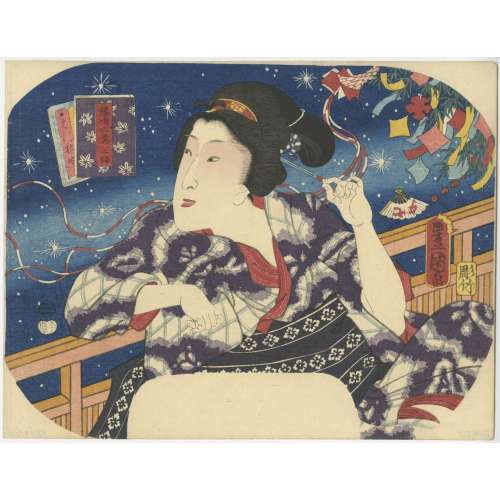 Artist: Utagawa Kunisada [歌川 国貞], a.k.a. Utagawa Toyokuni III [三代 歌川 豊国] (Japanese, 1786 – 1865). Signed: Toyokuni ga [豊国 画] in a red toshidama cartouche Block carver: Yokokawa Takejirō [横川竹二郎] (Japanese, fl. 1845 – 1863), seal: 彫竹 – Hori Take. Publisher: Ibaya Senzaburō [伊場屋仙三郎] (Japanese, fl. c. 1845 – 1847). Combined date and kiwame seal: Ansei 5 (II-XII/1858). Size: Untrimmed fan print (uchiwa-e), 300 x 232 mm.
Artist: Utagawa Kunisada [歌川 国貞], a.k.a. Utagawa Toyokuni III [三代 歌川 豊国] (Japanese, 1786 – 1865). Signed: Toyokuni ga [豊国 画] in a red toshidama cartouche Block carver: Yokokawa Takejirō [横川竹二郎] (Japanese, fl. 1845 – 1863), seal: 彫竹 – Hori Take. Publisher: Ibaya Senzaburō [伊場屋仙三郎] (Japanese, fl. c. 1845 – 1847). Combined date and kiwame seal: Ansei 5 (II-XII/1858). Size: Untrimmed fan print (uchiwa-e), 300 x 232 mm.A young woman adjusting her hairpin on a balcony during the Tanabata festival, as inscribed on the white folding fan: [七夕] (Tanabata).
Inscription on the blue book (print title): Early autumn [はつ秋や] (hatsu akiya), inscription on the purple book (series title): Short love songs, second volume [端唄の意 二編] (Hauta no kokoro nihen). According to Marks (2010), Hauta no kokoro nihen series of fan prints was published by Ibaya in 1858 (p. 267|P6871).
The series refers to love songs of a certain type popular in late Edo. They were performed with the accompaniment of a shamisen, “Seven herbs of autumn, the song of the insects is not heard; the bodies of lightning bugs are burnt, and the precious writings of love are getting thinner like the song of the insects as I am waiting for you. So, on an early autumn evening, I spot the glitter of a lightning bug that lingered among the autumn grasses, and while listening to the pine cricket, I am singing with my heart troubled by love". [Tokyo National Museum; translation provided by Elena Varshavsky].Tanabata [たなばた] or [七夕] – meaning "Evening of the seventh", also known as the Star Festival [星祭] (Hoshi matsuri) – is a Japanese festival originating from the Chinese Qixi Festival. One popular Tanabata custom is to write one's wishes on a piece of paper and hang that piece of paper on a specially erected bamboo tree, in the hope that the wishes become true.
-
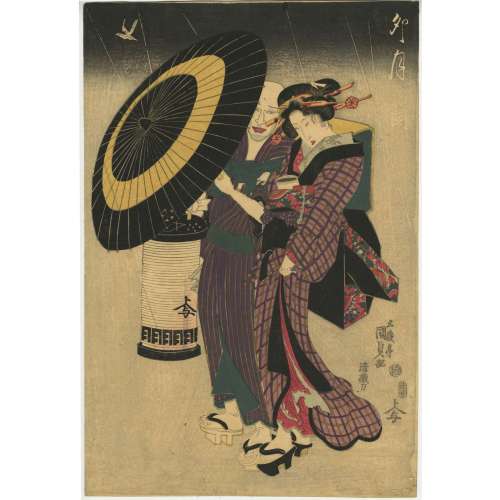 Utagawa Kunisada (Japanese: 歌川 国貞; also known as Utagawa Toyokuni III (三代歌川豊国); 1786 – 12 January 1865).
Utagawa Kunisada (Japanese: 歌川 国貞; also known as Utagawa Toyokuni III (三代歌川豊国); 1786 – 12 January 1865).A man with a shaved head (a monk), holding a paper lantern and an umbrella, walks with a young woman (a geisha) in the rain.
SIGNED: Gototei Kunisada ga [五渡亭国貞画]
Censor's seals: kiwame, futakata.
Blockcutter's mark: Seizô tô [改印:極、貳方]
MFA ACCESSION NUMBER 11.15150; MFA dating: about 1815–21 (Bunka 12–Bunsei 4);
Size: Vertical Ōban (382 x 260 mm). SOLD



